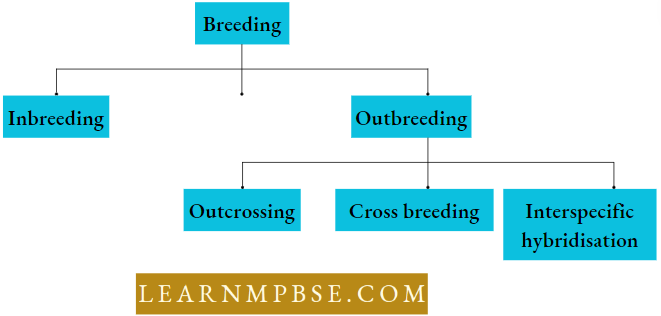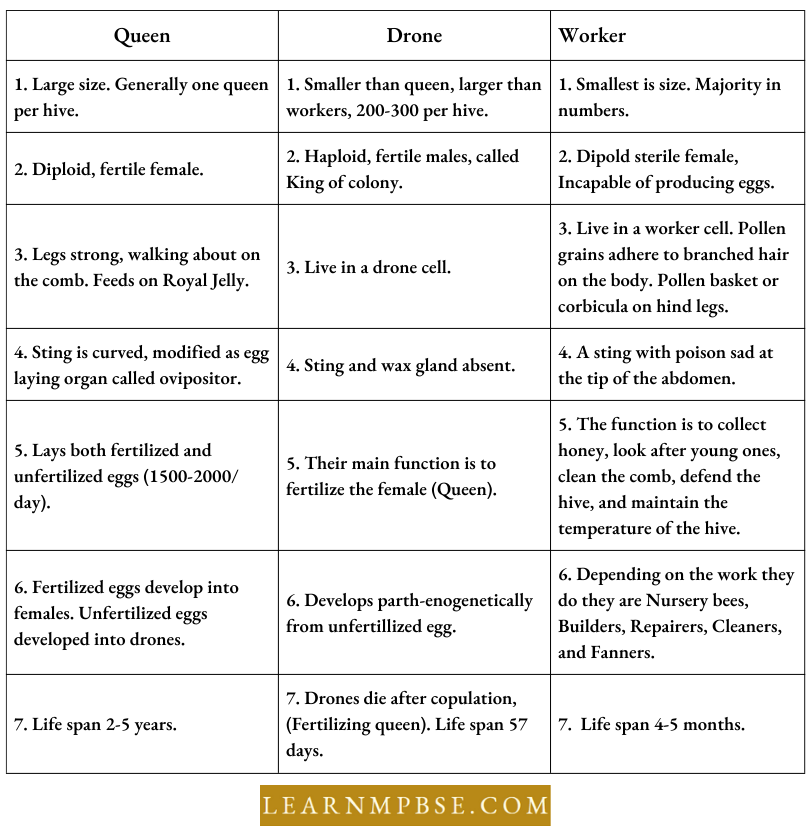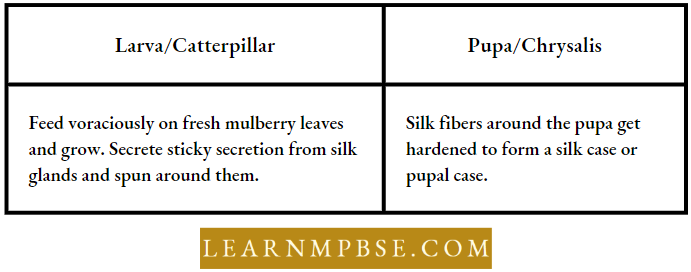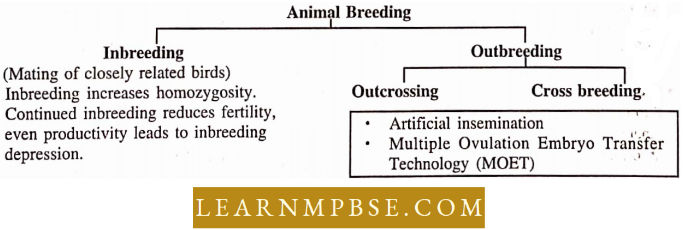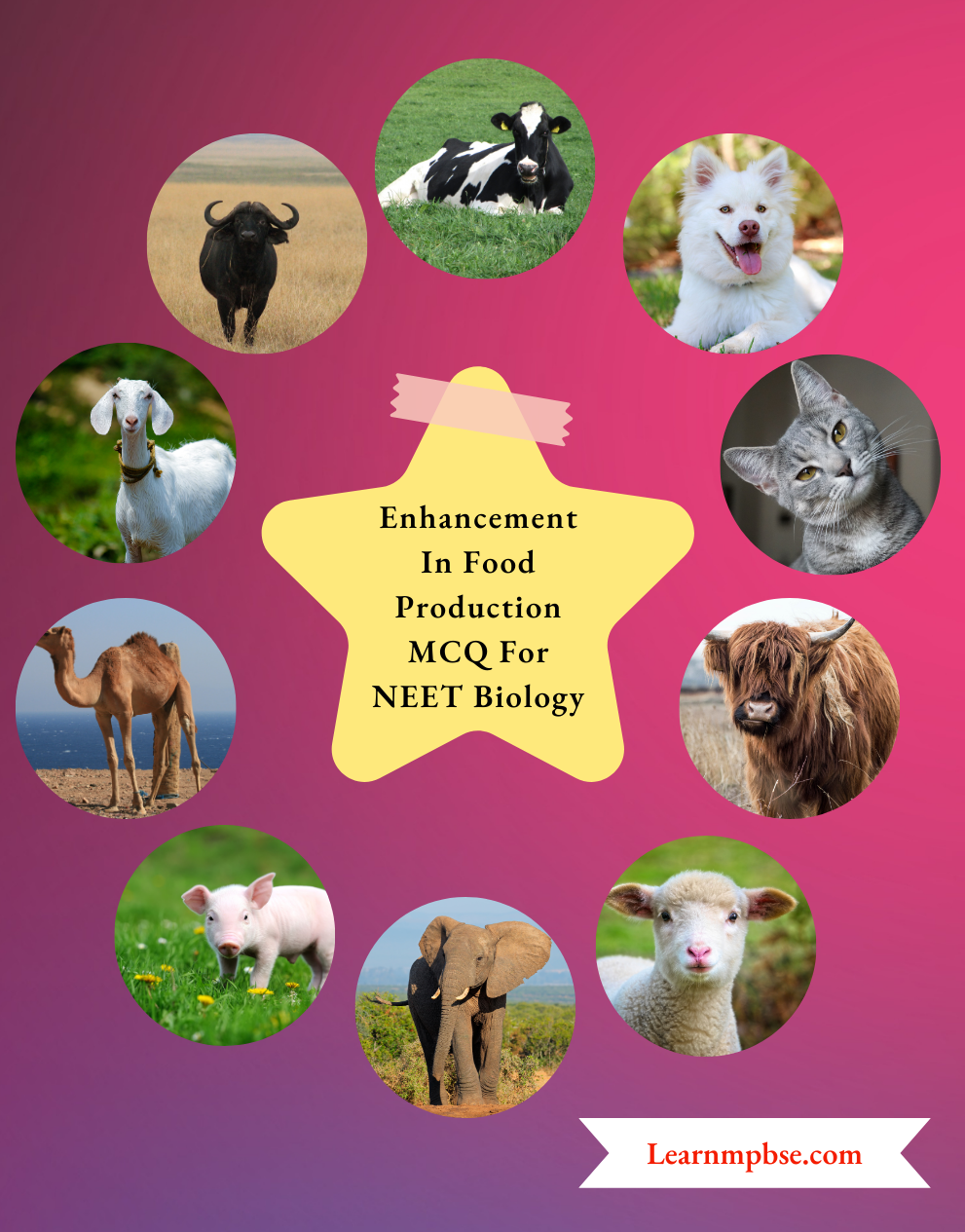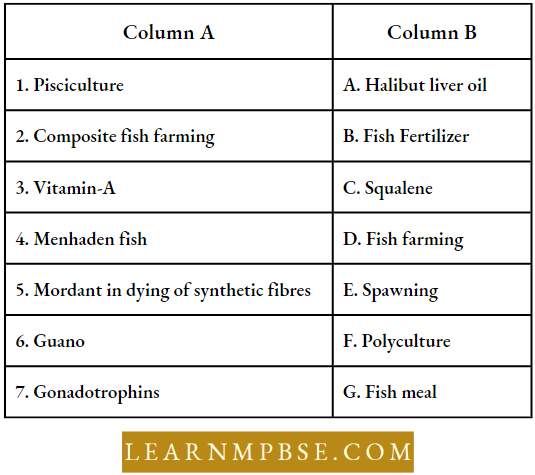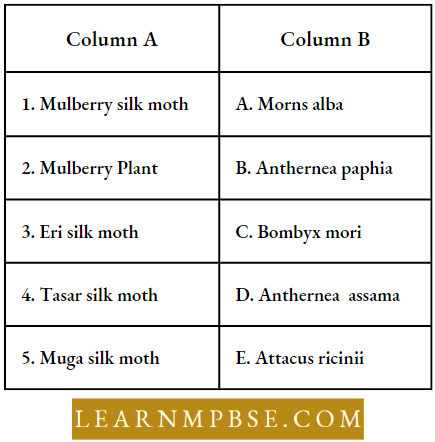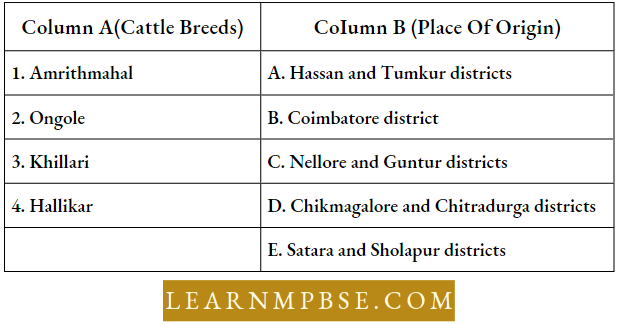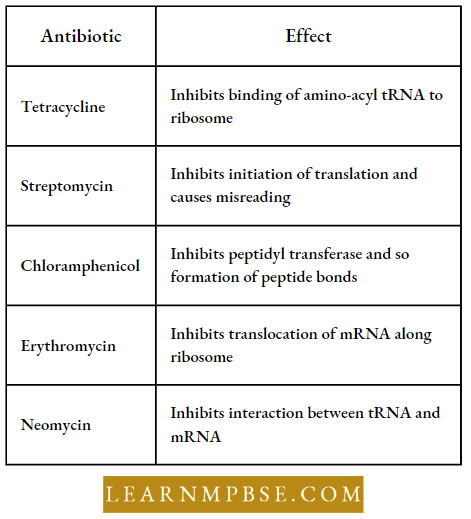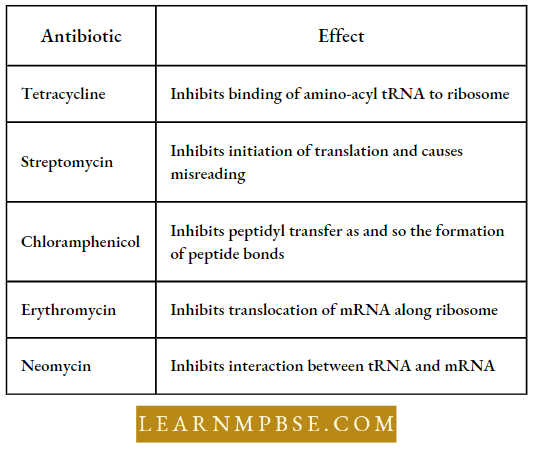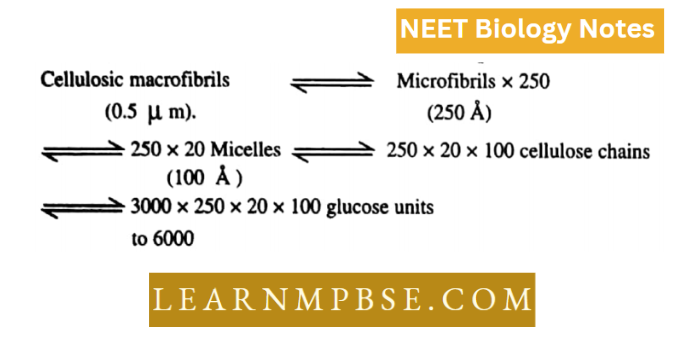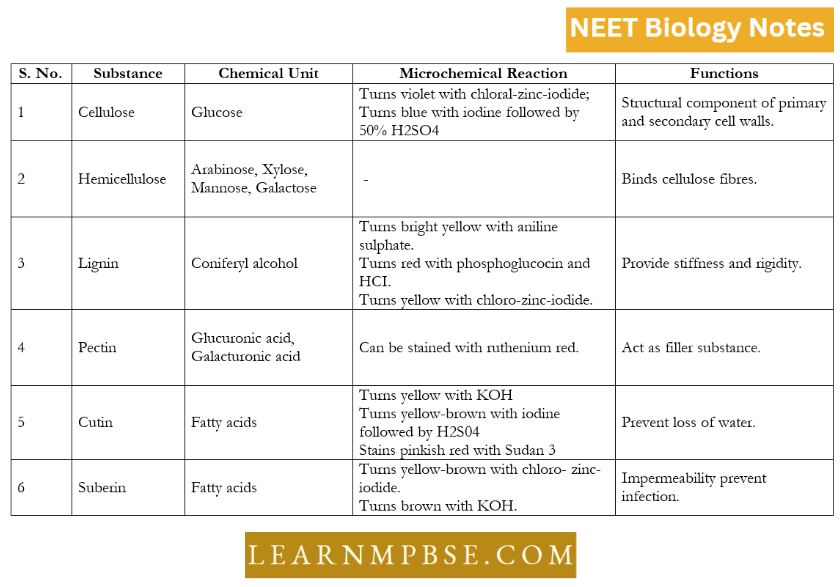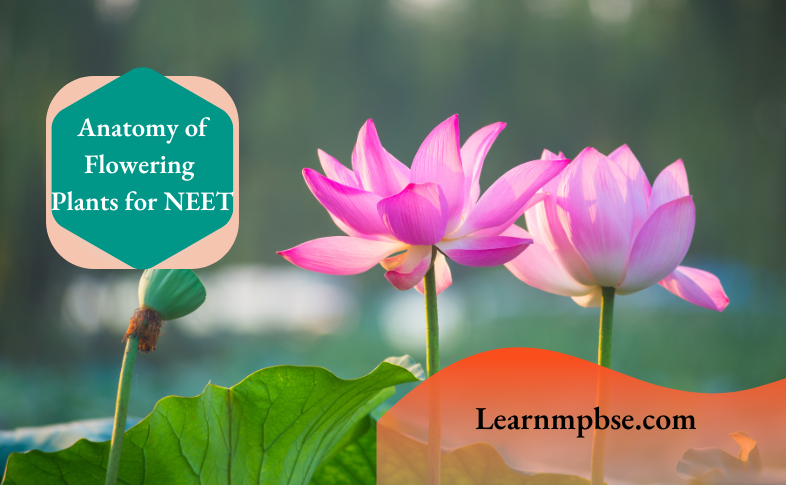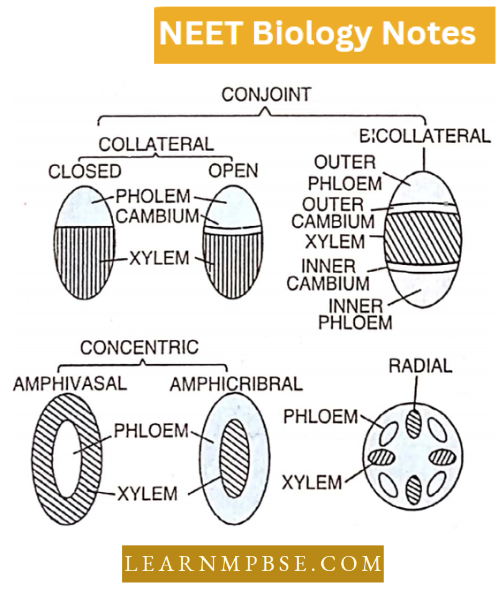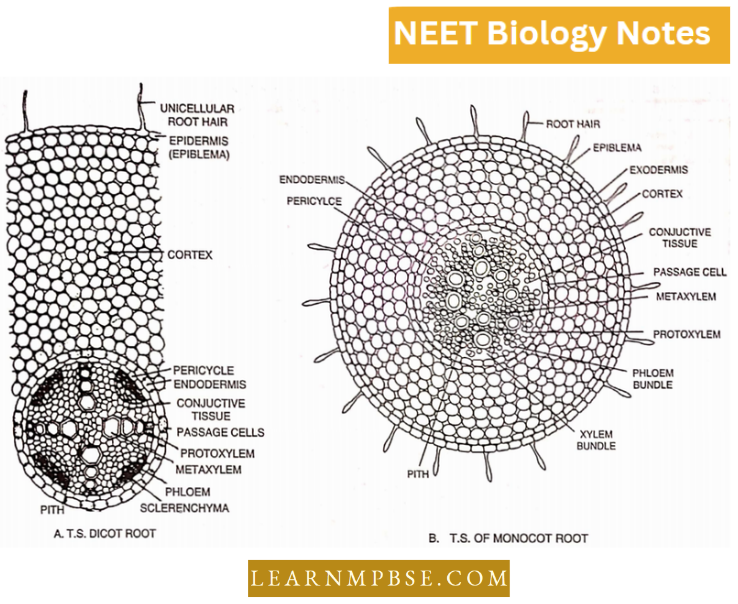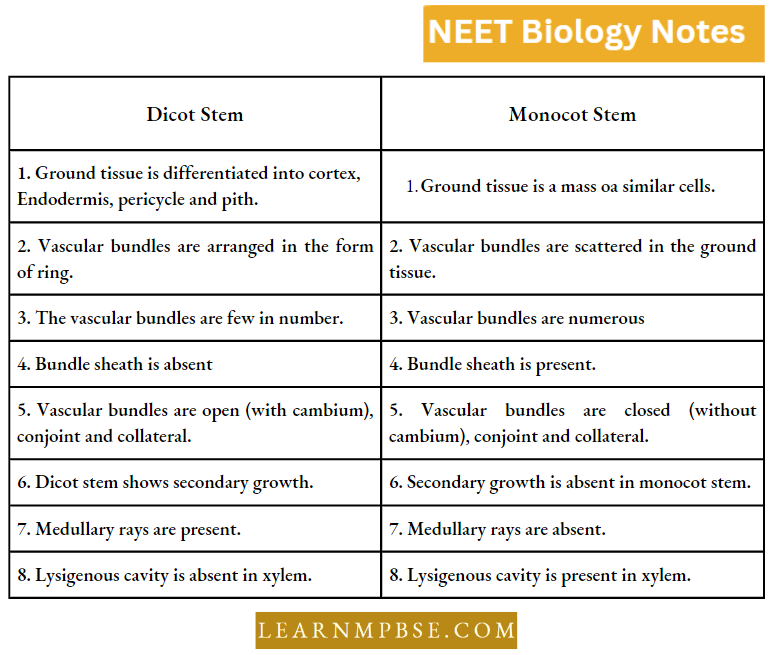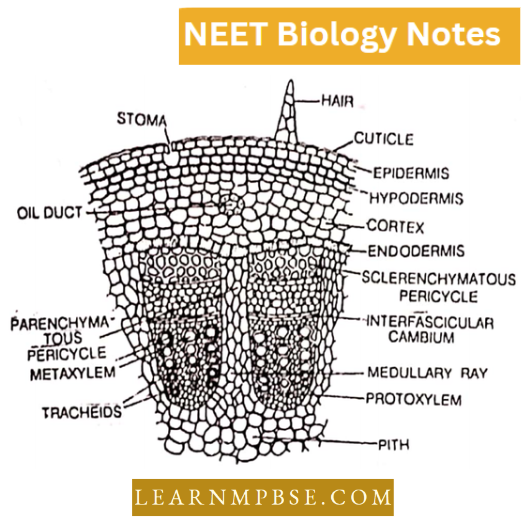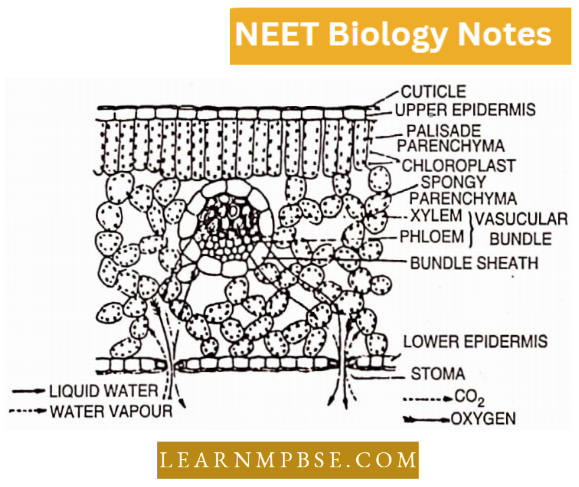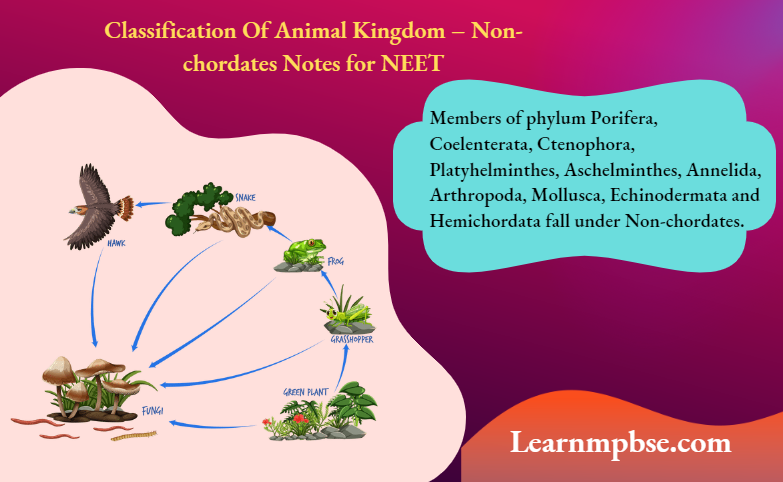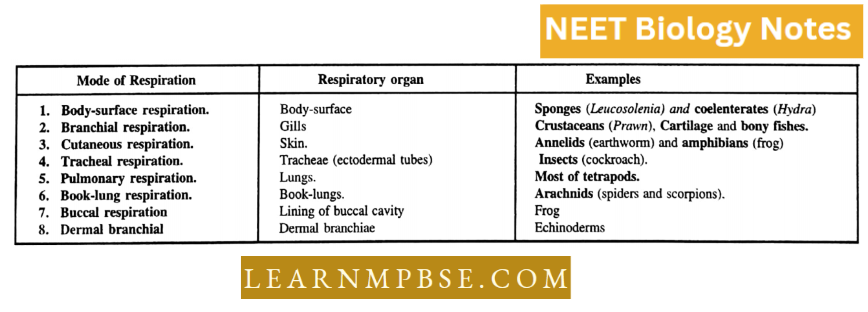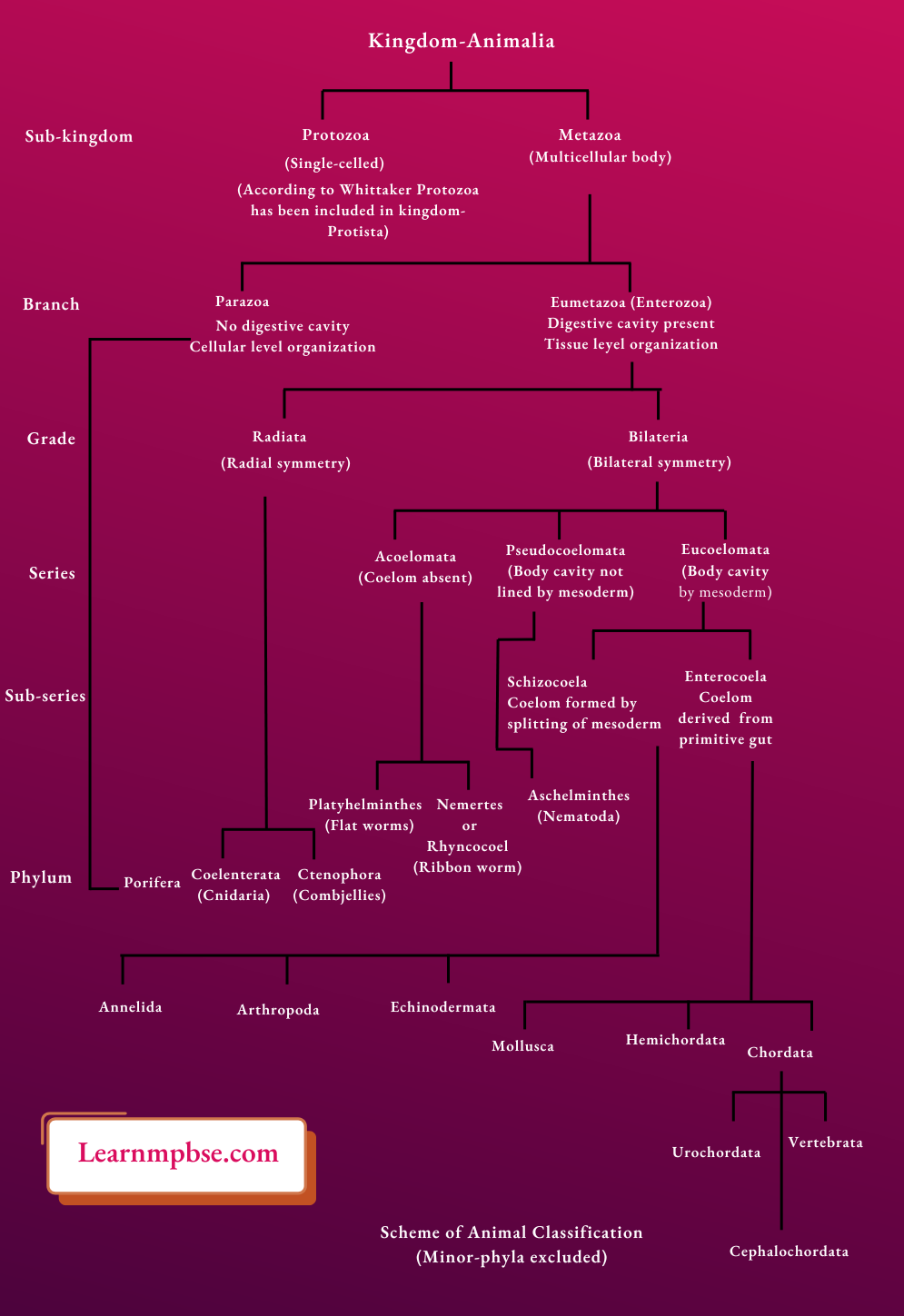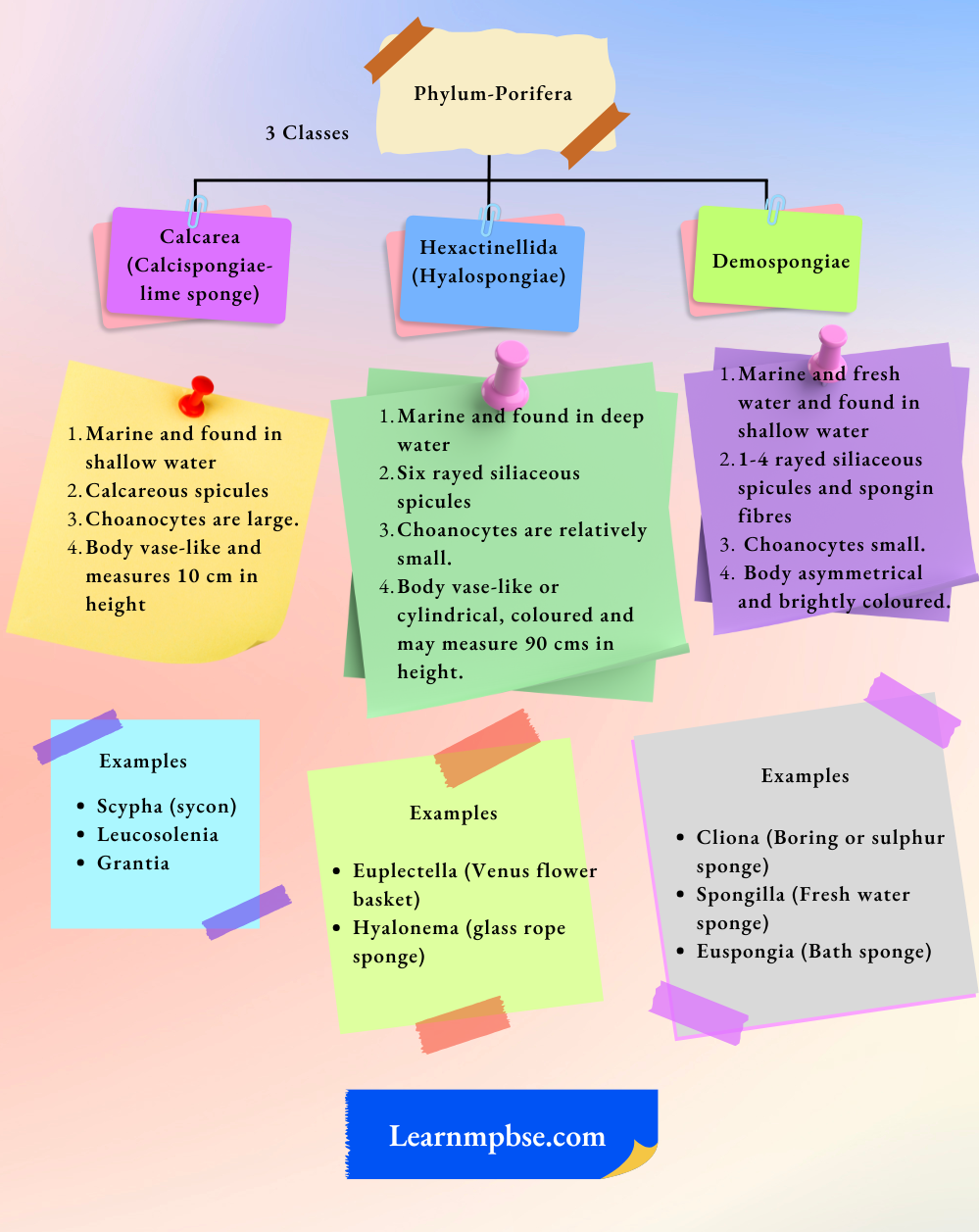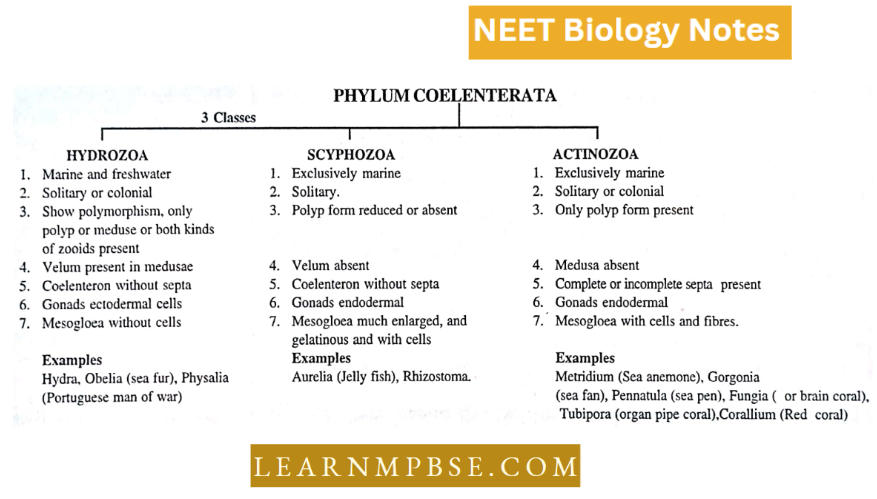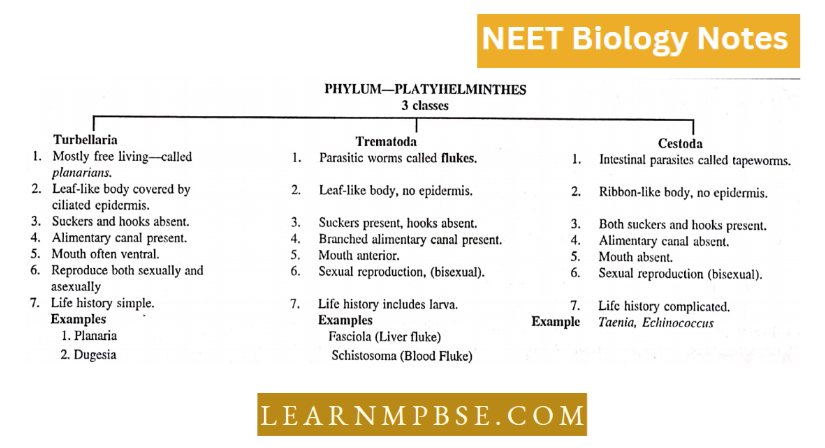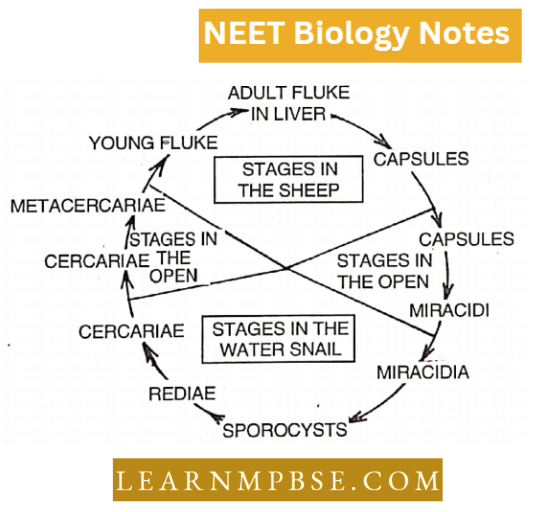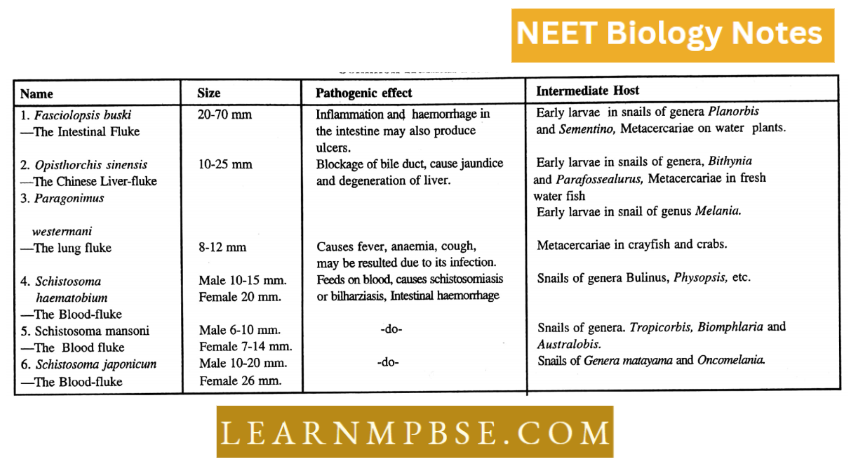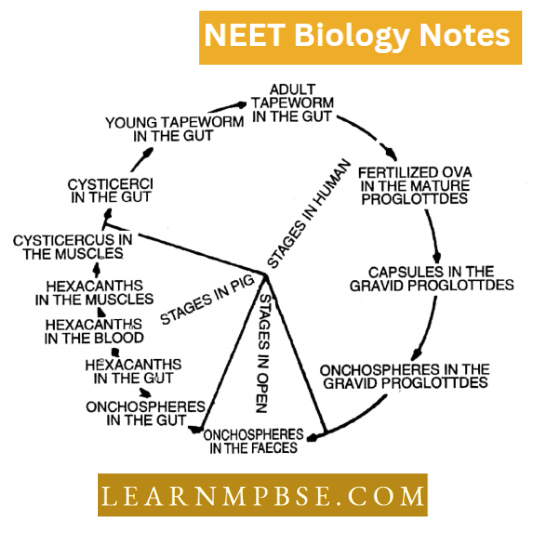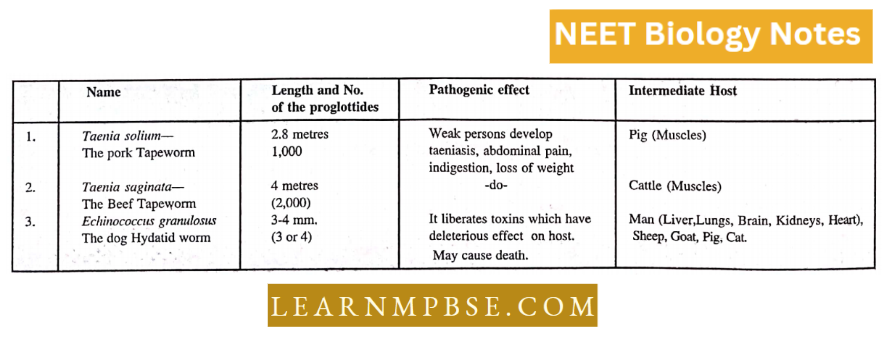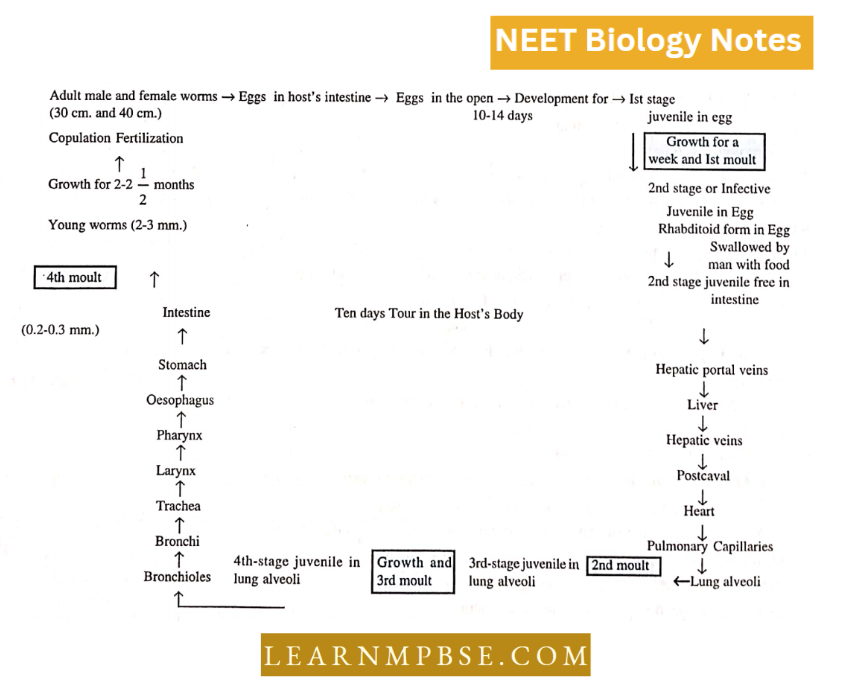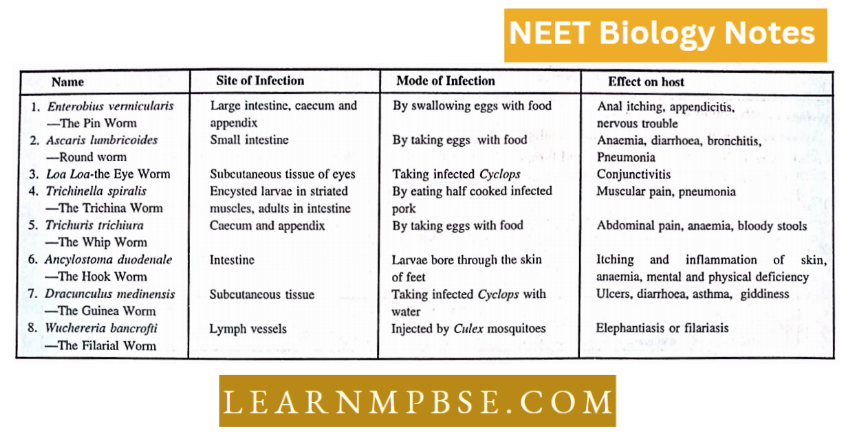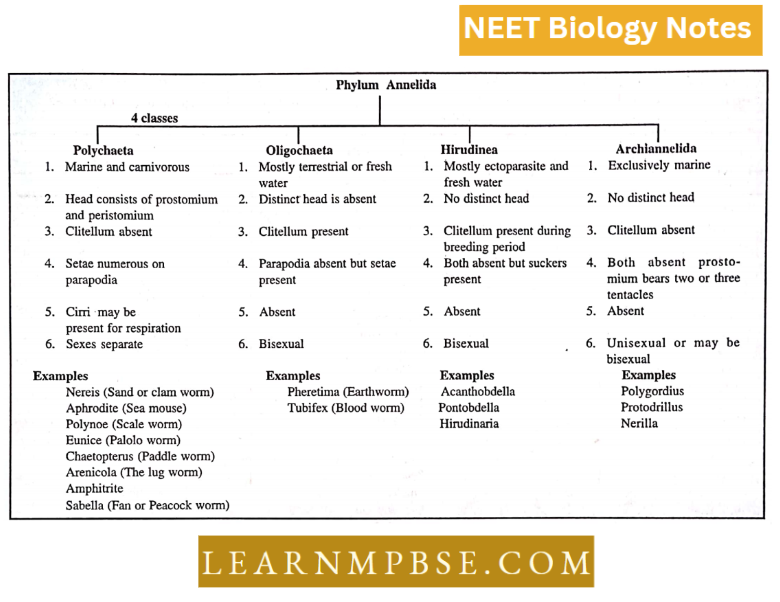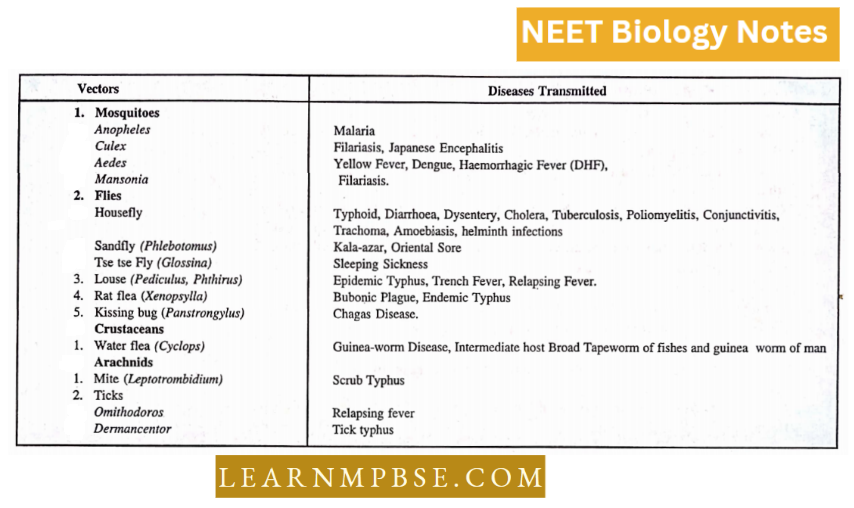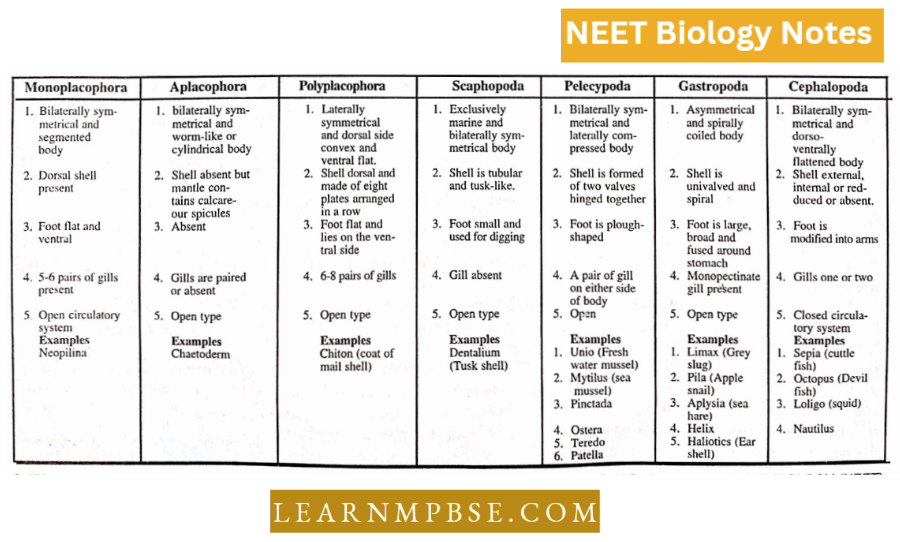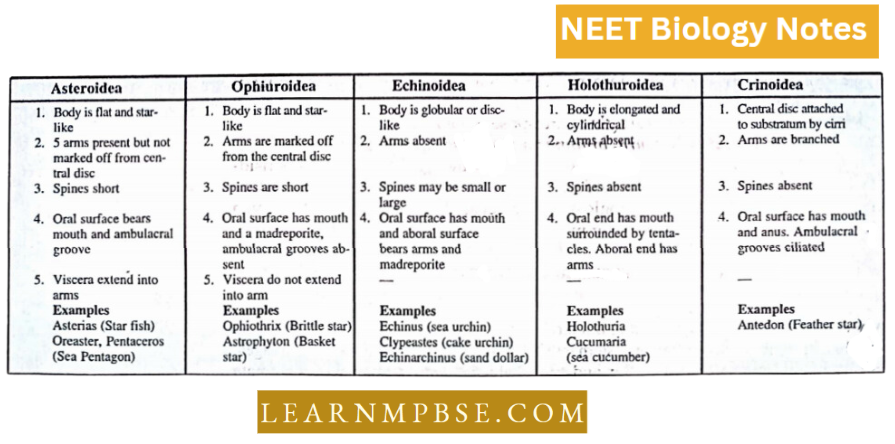NEET Biology Morphology Of Flowering Plants Inflorescence And Flower
Inflorescence:
The configuration and method of distribution of flowers on the plant’s stalk system is referred to as inflorescence.
- A flattened peduncle is referred to as a receptacle. A scape is a leafless peduncle that emerges from the ground level among basal leaves, as seen in onions.
- Cauliflower is the flowering of mature stalks. For instance, Artocarpic
NEET Biology Morphology Of Flowering Plants Notes
Types of Inflorescence:
- Racemose
- Cymose
- Mixed Type
- Special Type
1. Racemose or Indefinite. The main axis is not arrested and terminated by a flower. Flowers are arranged in acropetal succession. The opening of the flower is centripetal.
Kinds Of Racemose Inflorescence
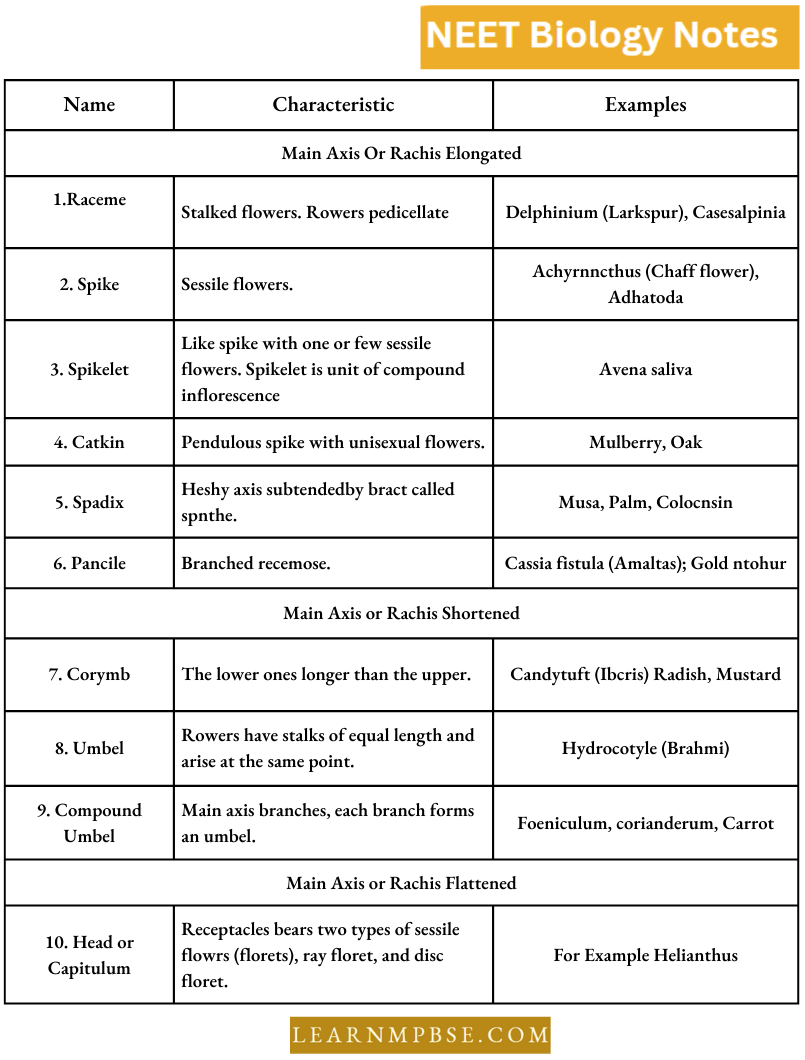
Neet Biology Morphology Of Flowering Plants Notes
Compound Racemose Inflorescence
- Raceme of Racemes (= Compound Raceme = Panicle). Racemes are borne acropetally on a raceme, For Example. Cassia fistula. Delonix regia, Yucca, Asparagus, Aspliodelus.
- Corymb of Corymbs (= Compound Corymb). An axis bearing several corymbs in a corymbose fashion, For Example. Pyrus, Cauliflower. Marketed Cauliflower (Brassica oleracea var. botrytis) represents an undeveloped inflorescence.
- Umbel of Umbels (= Compound Umbel). Many umbels develop from a common point in an umbellate fashion.
2. Cymose or Definite. The main axis and its branches bear flower buds at its apex. Consequently, the growth of the axis is checked. The flowers develop in basipetal succession.
The order of opening of flowers is centrifugal. It is of three types :
- Monochasial
- Dischasial and
- Polychasial
Morphology Of Flowering Plants Neet Notes
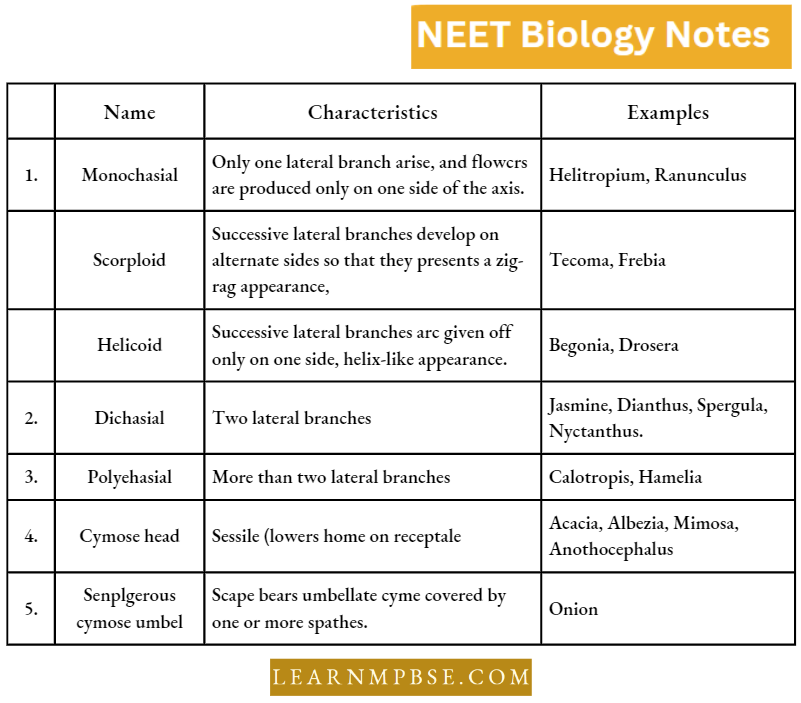
Morphology Of Flowering Plants Neet Notes
3. Mixed Inflorescence
- Thyrsus (Thyrse). Cytnose clusters arranged acropctally For Example, Vilix vinifera (Grape Vine).
- Mixed Spadix (Spadix of Cymes). Spadices having cytnose inflorescence arranged acropctally on fleshy axis. For Example. Banana.
- Panicle of Spikclets. Spikelets arranged in a compound raceme, For Example., Oat, Rice.
- Corymb of Capitula, For Example., Agcratum.
- Other Types like umbel of capitula. cyme of capitula (For Example. Vcnionia), cyme of umbels (For Example. Lantana). cyme of corymbs, etc.
4. Special Types of Inflorescence
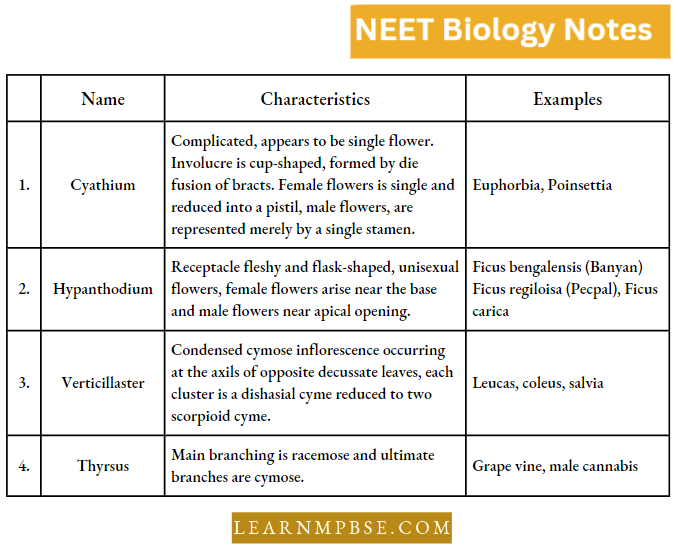
Neet Morphology Of Flowering Plants Chapter Notes
Importance of Inflorescence
- It provides more chances for cross-pollination.
- Inflorescence makes flowers more conspicuous. Thus insects are attracted to pollination.
- A large inflorescence also enhances the chance of wind pollination and simultaneously in many flowers.
- An insect can pollinate many flowers in inflorescence in a single visit.
Neet Morphology Of Flowering Plants Chapter Notes
NEET Biology Morphology Of Flowering Plants Flower
A flower is a reproductive shoot that bears sex organs and performs the following functions,
- Production ofpollen and ovules,
- Pollination
- Fertilization
- Development of fruit, and seeds and their dispersal.
- Achlamydeous. A flowering lacking both calyx and corolla, For Example., flowers in a cyathium inflorescence.
- Complete. A flower with all four whorls.
- Neutral. When sex organs are not developed, For Example., ray florets of sunflower.
Sex-Distribution
- Bisexual, perfect, or monoclinous. A flower with both sexual organs, i.e., stamens and pistils.
- Unisexual, Imperfect, or diclinous:
- Monoecious. Both male and female flowers are present in the same plant.
- Dioecious. Male and female flowers are present in the different plants.
- Polygamous possess more than two types of flowers For Example. Mango and cashew nut trees possess three types of flowers—bisexual, staminate, and neuter.
- Isoniery. The presence of the same number of floral parts is termed isometry. An isomeric flower is known after the basic number as trimeric (3 or multiple of three in each series), tetramerous (four), pentamerous, or numerous. If different floral organs have different basic numbers it is termed heteromer.
Arrangement Of Floral Parts
- Acyclic. (spiral) Floral organs are arranged in spirals, For Example., Magnolia, Opuntia, and Nymphaea.
- Cyclic. Floral organs are arranged in whorls, For Example., Solamun.
- Hcmicyclic (spiro-cyclic). Floral organs are partly in spirals and partly in whorls, For Example., Anona.
Morphology Of Flowering Plants Class 11 Notes For NEET
Floral Parts
- Perianth. Collective terms when petals and sepals are not distinguished.
- Tepal. A seg-ment of perianth. May be sepaloid or petaloid.
- Polyphyllous. In such flowers, tepals are free.
- Gamophyllous. In such flowers, tepals are fused.
- Perianth segment of the family Gramineae are called Iodicules (Small fleshy, translucent)
- Calyx. It is the outermost series of non-green floral organs called sepals.
- Caducous. Falls away as the bud opens, For Example. Poppy.
- Deciduous. Falls away just after pollination.
- Persistent. Remains attached in the fruit, For Example. Brinjal.
- Accrescent. Growing along with fruit, For Example. Physalcs
- Marcescent. Dried appearance For Example. Piper, Guava, Asphodelus
Aestivation
- Valvate, arrangement without overlapping For Example., Custard apple, Acacia.
- Twisted all are in and out or Contorted, For Example., china-rose.
- Imbricate, For Example., Cassia
- Quincuncial. A form of imbricate where two petals or sepals are external, two are internal, and one is partly internal and partly external, For Example., Guava.
- Vexillary or DescendingImbricate, five petals present, posterior outermost, anterior innermost, laterals in and out, For Example., Pea.
Different conditions of sepals are as follows:
- The state of free sepals is called polysepalous (or choriscpalous), whereas the condition of fused sepals is designated as gamosepalous (or synsepalous).
- Based on the incisions, the gamosepalous calyx is classified as toothed (with minimal incisions), find (incisions extending midway), partite (incisions approaching the base), and connate (fused solely at the base).
Morphology Of Flowering Plants Class 11 Notes For NEET
Gamosepalous calyx can have various shapes:
- Campanulate. Bell-shaped, For Example., Shoe Flower (= China Rose),
- Cupulate, Cup-like, For Example., Gossypium.
- Infundibuliform. Funnel-shaped, For Example. Atropa.
- Urceolate. Um-shaped, For Example., Silene(v) Globose, For Example., Physalis.
- Tubular. Tube-like, For Example., Datura, Verbena,
- Spurred. Beak-Ike, For Example. Delphinium (Larkspur),
- Bilabiate. With two lip-like structures, For Example., Ocimum, and Salvia.
- Pappus. Hair-like sepals, For Example., Sonchus, Tagetes
- Spinous. Trapa.
A sepal lying in line with the mother axis is an odd sepal if the number of sepals is 3 or 5. Odd sepal is generally posterior (For Example. Solanum, Hibiscus) but is anterior in Leguminosae (For Example., Pea, Acacia, Cassia) and a few others. Sepals colored other than green are called petaloids.
Epicalvx
It is an additional whorl of sepal-like structures formed by bracteoles that occur on the outside of the calyx. Epicalyx occurs in the family Malvaceae (For Example. Shoe Flower, Cotton, Althaea) and some rosaceous flowers.
Corolla
It is a whorl of the non-green, colored leaf-like non-essential floral organ that forms a series inner to calyx. It is meant to attract pollinating insects.
Some Descriptive Terms Concerning Corolla
- Polypetalous corolla Choripetalous—It is a condition of free petals. It is of the following types.
- Cruciform. Presence of four, free, unguiculate petals arranged in the form of a cross For Example. Brassica (Sarson). Each unguiculate petal consists of a lower narrow’ portion called a claw and an upper broad portion limb.
- Caryophyllaceous. There are five unguiculate petals. The limbs of petals spread outward and lie’ at the right angle of the claw For Example. Dianthus (Pink) and Carnation etc.
- Rosaceous. The petals are five or more than five having very reduced or sessile claws and large broad limbs spreading outwardly For Example. Rose.
- Papilionaceous. It is a butterfly-shaped irregular corolla consisting of five petals. The posterior petal is the largest known Standard or Vexillum. Two lateral petals are small and free called Wings or Alae, and are overlapped by the posterior standard petal.
- The two anterior petals are fused to form the innermost boat-shaped structure covering the stamens and carpel of the flower and are spoken as Keel or Carina.
- It is overlapped by wings or alae For Example. members of the family Papilionaceae For Example. Pea.
- Gamopetalous (sympetalous) Corolla: It is a condition of fused petals. It has several shapes
- Campanulate. Like a bell, For Example. Cucurbita.
- Hypocrateriform or Salver-Shaped. Tubular with spreading lobes, For Example., Clerodendron.
- Infundibuliform. Like a funnel, For Example. Petunia.
- Urceolate. Um-like.For Example. Bryophylliun.
- Tubular. Like a tube, For Example., disc florets of Sunflower,
- Ligulate (Strap-Shaped). Flat limb with a tubular base, For Example., ray florets of Sunflower,
- Rotate. Short tube with spreading lobes For Example., Solatium nigrum,
- Spurred. With a beak, For Example., Larkspur,
- Bilabiate. Bilipped or with two lips. The mouth can be open (bilabiate ringent, For Example. Salvia, Ocimum) or closed (bilabiate personate, For Example.. Antirrhinum or Dog Flower).
NEET Biology Morphology Of Flowering Plants Important Points
Incision of gamopetalous corolla may be toothed, fid, and partite. Aestivation can be open (margin sufficiently apart), valvate (no overlapping, margins just touching), twisted (= contorted, regular overlapping of one margin), and imbricate (irregular overlapping).
- Imbricate aestivation has three special types—quincuncial (two overlappings, two overlapped, One with one margin overlapping while the others being overlapped), ascending price (posterior being overlapped by lateral, and lateral being overlapped by anterior petals.
- For Example., Cassia) and descending imbricate (posterior overlapping lateral ones and lateral the anterior petals = vexillary = papilionaceous, For Example.. Pea).
Androecium
It is a collective name of the stamens or male reproductive organs of a flower. Each stamen has two parts, a thread-like stalk called filament and a knob-like terminal anther.
- An anther has two lobes (whether lobes) attached by a sterile band called a connective. Elongation of connective makes the anther lobes divergent (= divaricate) or distractile (anther lobes at the two ends of elongated connective).
- Anther is vitreous (with two lobes) in most cases. In the family Malvaceae (For Example., Shoe Flower, Cotton) anthers are single-lobed and are called monoecious.
Terms Related With Androecium
- Polyandrous. All the stamens are free in the androecium For Example. Brassica.
- Epipetalous. Filaments of the stamens adnate.with petals. It is found mostly in gamopetalous corolla For Example. Petunia, Brinjal.
- Epiphyllous. Stamens arising from tepals For Example. Asphodelus.
- Episepahnis. Stamens attached with sepals For Example. Verbena.
- Gynandrous. When the anthers of stamens united with the stigma of carpels forming the gynostegium Example. Calotropis (Ak)
- Inserted. Stamens are shorter than the corolla tube and remain hidden inside it For Example. Petunia.
- Exerted. When stamens come out from the corolla tube For Example. Acacia.
- Didynamous. There are four stamens out of which two stamens are larger and two are shorter in length For Example. Ocimum, Salvia.
- Tetradynamous. There are six stamens of which four stamens are large and two are short For Example. Brassica campestris.
- Alternipetalous. There is a single whorl of stamens. The number of stamens is equal to the number of petals and they alternate with the petal lobes For Example. Solanum nigrum, Petunia. In the case of tepals, the condition is alterniphyllous.
- Antipetalous. Same as above, but the stamens are present opposite to the petal lobes For Example. Coriander. In the case of tepals, the condition is antiphyllous.
- Diplostemonous. The stamens are double the number of petals and present in two whorls. The inner whorl of stamens is alternating with petals (alternipetalous), while the inner whorl is opposite to petals (antipetalous) For Example. Cassia and Murraya exotica.
- Obdiplostemonous. It is the reverse of diplostemonous. The outer whorl of stamens is opposite to petals (antipetalous) while the inner whorl of stamens is alternating with petals (alternipetalous) For Example. Pink.
- Isostemonous. All the stamens in a flower are alike in shape, size mode of dehiscence, etc.
- Heterostemonous. The stamens in a flower differ in their shape, size, and mode of dehiscence.
- Adelphous. The stamens are fused by their filaments but the anthers are free. If the filaments of all the stamens fuse to form one group, it is termed monadelphous For Example.
- Hibiscus rosa sinensis. When they are fused in two groups called diadelphous For Example. Pea, or sometimes fused in more than two groups and described as polyadelphous For Example Citrus.
- Syngenesious or Synantlierous. In this case, the filaments of stamens are free and anthers are fused by their sides to form a ring around the style For Example Sunflower.
- Synandrous. When both filaments and anthers of the stamens are fused completely.
NEET Biology Morphology Of Flowering Plants Important Points
Gynaecium
It is the collective name of Carpels or female reproductive parts. The free unit of gynaecium is called a pistil. Each pistil has a stigma, style, and ovary.
Terms related to gynaecium
- Unilocular Ovary. One Chamber For Example. Pea, Sunflower.
- Bilocular Ovary. Two Chambers For Example. Petunia.
- Trilocular Ovary. Three Chambes For Example. Asphodelus.
- Tetralocular Ovary. Four Chambers For Example. Ocimum.
- Pentalocular Ovary. Five Chambers For Example. Hibiscus.
- Multilocular. More than five Chambers For Example. Althaea.
- Apocarpous. There are two or more carpels in a gynaecium that are free from each other For Example. Ranunculus (Buttercup), Aconitum.
- Syncarpous. In this form, two or more carpels are fused to form a single compound ovary For Example. Petunia, Althaea, etc.
Placentation :
- Marginal For Example. Pea.
- Parietal For Example. Papaya, mustard.
- Axile For Example. China-rose, Petunia.
- Free central For Example. Dianthus.
- Superficial, For Example. Lotus.
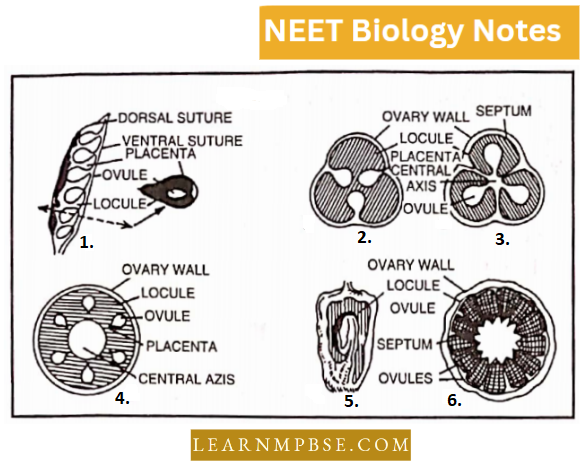
- Marginal (L.5.) and (C.5)
- Parietal
- Axile
- Free central
- Basal
- Superficial
NEET Biology Morphology Of Flowering Plants Important Points
Forms Of Ovules
- Orthotropous or Straight. The ovule is erect. Funicle, chalaza and micropyle lie on the same vertical line, For Example., Polygonum, Rumex.
- Anatropous or Inverted. Ovule bends along the funnel. Micropyle lies close to the hilum. Micropyle and chalaza lie on the same vertical line For Example., Solanum, Anemone, Helianthus.
- Amphitropous or Transverse. The ovule is placed transversely or right angle to its stalk, For Example., Lemna.
- Campylotropous or Curved. Chalaza and micropyle do not lie in a straight line. For Example. Capparis, Mustard, Pisum.
- Circinotropous. In this, the ovule is inverted at an angle of 360° so that the ovule again becomes orthotropous and coiled around by funiculus For Example. Opuntia.
- Hemitropous. This body is curved.

Relative position of floral parts on the thalamus
The arrangement of floral leaves on the thalamus varies and is of the following types :
- Hypogyny. When the various whorls of flower are arranged below the ovary, the carpel occupies the central position, and other floral parts airborne below it in their respective whorls. Such flowers are called hypogynous Examples. china rose. In such a case ovary is called superior and other parts are inferior.
- Perigyny. If the thalamus is flattened out to form a disc or a cup or flask-shaped top, the gynaecium will be placed not on the top of the flower but in the center. The remaining three whorls of flower (calyx, corolla, and androecium) are usually inserted on the rim of the disc or cup or flask-like thalamus.
- Epigynous. The thalamus is a hollow cup or flask-like but the ovary is completely fused with the inner wall of the thalamus or receptacle. Gynaecium is inferior. Other parts are superior For Example. sunflower, coriander, and apple.
NEET Biology Morphology Of Flowering Plants Revision Notes
Inflorescence (An Axis Bearing Flowers)
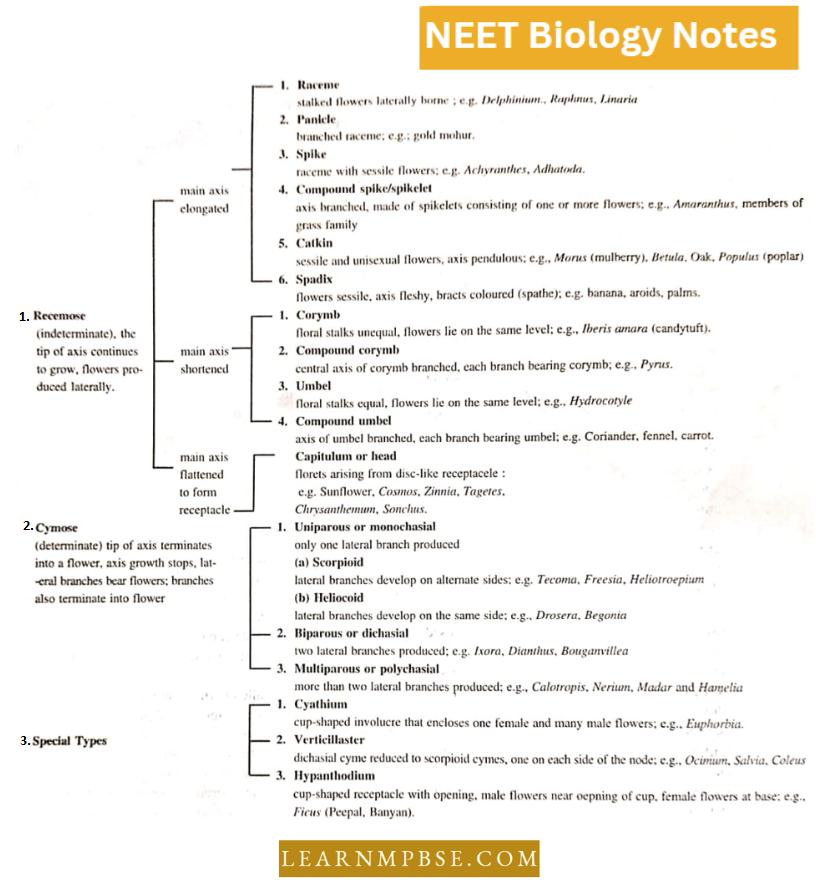
Anthotaxis is the arrangement of flowers on the axis of the peduncle For Example. acropetal, basipetal, centripetal.
- Strobile is a spike in which the flowers develop in the axils of persistent membranous bracts For Example. Humulus (hop).
- Thyrsus is a type of mixed inflorescence when cymose clusters are arranged acropetally For Example. grapevine. Puya raimondii (32 ft.) is the largest inflorescence of world.
- Coenanthium is open hypanthodium.
- Petaloid bract is found in Bougainvillea.
- The largest Indian inflorescence is Amorphophallus.
- In rhipidium scorpioid cyme, the lateral branches are present on the same plane For Example. Solatium nigrum.
- In the cincinnus scorpioid cyme, the lateral branches are present on angular planes.
NEET Biology Morphology Of Flowering Plants Revision Notes
NEET Biology Morphology Of Flowering Plants Quanta To Memory
Mussaenda. The odd sepal is enlarged to form a leafy structure.
- Longest Inflorescence. Agave (12 m), Amorphophalus (5.5 m).
- Anthotaxy or Anthotaxis. The arrangement of flowers on the peduncle is called anthotaxy or anthotaxis.
- Goethe (1790) suggested that a flower is a modified shoot. Sepals and Petals or Tepals are the non-essential appendages of a flower.
Stamens and carpels are the essential appendages of a flower.
- Complete flowers bear sepals, petals, stamens, and carpels.
- Tepals collectively form Perianth.
- Polygamous. A plant having male, female, and intersexual flowers, For Example., Mango.
- Trioecious. A species with three types of individuals, male, female, and monoecious.
- Andromonoecious. A plant having male and intersexual flowers, For Example., some Lilies.
- Gynomonoecious. A plant having female and intersexual flowers, For Example., Sunflower.
- Stylopodium. Sunflower base of style.
- Sexual Reproduction in Plants. First studied by Camerarius (1694).
- Most Common Type of Ovule. Anatropous (92%).
- The union of stigma with the stamen is called gynostegium.
- Coronary corona is found in Calotropis.
- Staminal corona is found in Nerium.
- Stamens are branched in Ricinus (castor).
- Syngenesious stamens are those where anthers are fused and filaments are free, For Example., Compositae.
- Sagittate (arrowhead-like) anthers are found in Vinca.
- Stylopbdium is the swollen base of the style in Foenicuhim, Coriandrum, etc.
- A funnel-shaped stigma is found in Crocus.
- Persistent, wheel-like stigma occurs in Papaver (poppy):
NEET Biology Morphology Of Flowering Plants Revision Notes
In cymose-type inflorescence, the growth of the mother axis is definite due to the formation of a flower at the tip.
- In the racemose type of inflorescence, the growth of the mother axis is indefinite.
- Spike differs from raceme in having sessile flowers.
- A spike with a fleshy axis and enclosed by a bract (spathe) is called a Spadix.
- Spikate Head (Capitate Head). The inflorescence of Mimosa, Acacia, and Albizzia is not centrifugal but is centripetal.
- Hypanthodium type of inflorescence is present in Ficus.
- Cup-shaped involucre having a single female flower surrounded by male flowers are the characteristics of cyathium inflorescence, For Example., Euphorbia.
- Monochasial Cyme. Helicoid is of two types :
- drepanium (flowers of different branches in one plane) and bostryx (flowers of different branches in different planes). Similarly, scorpioids are of two types: rhipidium (flowering in one plane) and cincinnus (flowers in different planes).
When calyx is modified into bristle or hair, it is called pappus, For Example., Compositae.
- In the valvate type of aestivation, sepals or petals meet edge to edge without overlapping each other.
- When the filaments are fused to form more than two bundles and anthers are free, the condition is called polyadelphous.
- The intercalary inflorescence is found in Callistemon (Bottlebrush).
- The terminal flowerless portion of the peduncle of the spadix elongates to form an appendix.
- The capitulum (Racemose head) is the most advanced type of inflorescence.
- Pistillode is a sterile carpel.
- The ovules are generally supported by a stalk known as a funicle.
- Erect ovule is called orthotropous.
- In onion and garlic, scape is a hollow, unbranched, long peduncle that bears terminally a cymose cluster of flowers in an umbellate manner.
- Thyrsus. This is an inflorescence in which many cymose clusters are borne acropetally on an unlimited axis in the manner of a raceme. Examples are the grapevine, and lilac.
Morphology Of Flowering Plants NEET Chapter Summary
NEET Biology Morphology Of Flowering Plants Questions From Competitive Examinations
Question 1. Placentation in legumes is :
- Basal
- Marginal
- Axile
- Free central.
Answer: 2. Marginal
Question 2. Bicarpellary gynaecium and oblique ovary occur in :
- Mustard
- Banana
- Pisum
- Brinjal.
Answer: 4. Brinjal.
Question 3. The tetradynamous condition occurs in :
- Cruciferae
- Malvaceae
- Solanaceae
- Liliaceae.
Answer: 1. Liliaceae.
Question 4. An example of a polypetalous zygomorphic corolla is :
- Crotalaria
- Ocimum
- Mustard
- Rose
Answer: 1. Crotaloria
Question 5. Palynology is the study of :
- Palms
- Flowers
- Fruits
- Pollen grains.
Answer: 4. Pollen grains.
Morphology Of Flowering Plants NEET Chapter Summary
Question 6. Which of the following is a wrong pairing?
- Cyme – hibiscus
- Corymb – caecalpinia
- Spike – crotalaria
- Verticillaster – Leucas.
Answer: 3. Spike – crotalaria
Question 7. What kind of inflorescence is found in Apiaceae
- Umbel
- Catkin
- Cymose
- Hypanthodium.
Answer: 1. Umbel
Question 8. A beautiful whorl which encloses the whole of implore- science is :
- Bract
- Involucre
- Spathe
- Spadix.
Answer: 2. Involcure
Question 9. Trimerous unisexual flowers occur in :
- Tamarind
- Cocos
- Pea
- Hibiscus.
Answer: 2. Cocos
Question 10. Choose the mismatched option.
- Wind-cannabis-anemophilous
- Water-zoortera-hydrophilic
- Insects-salvia-entomophile
- Birds-adansonia-ornithopinily
- Bats-kigelia-chiropterophilly.
Answer: 4. Bats-kigelia-chiropterophilly.
Question 11. Unisexuality of flowers prevents :
- Geitonogamy, but not xenogamy
- Autogamy and geitonogamy
- Autogamy, but not geitonogamy
- Both geitonogamy and xenogamy.
Answer: 3. Autogamy, but not geitonogamy
Morphology Of Flowering Plants NEET Chapter Summary
Question 12. In the monocotyledonous seeds, the endosperm is separated from the embryo by a distinct layer known as:
- Testa
- Aleurone layer
- Tegmen
- Scutellum
- Coleoptile.
Answer: 2. Aleurone layer
Question 13. The fleshy receptacle of the syconus of fig encloses many:
- Berries
- Mericarys
- Achenes
- Samaras.
Answer: 3. Achenes
Question 14. Match List 1 with, List 2 and select the correct option.
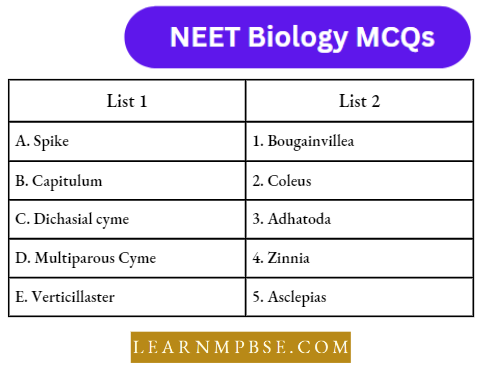
- (A)-3, (B)-1, (C)-1, (D)-5, (E)-2
- (A)-3, (B)-1, (C)4,: (D)-5, (E)-2
- (A)-2, (B)-4, (C)-1, (D)-5, (E)-3
- (A)-4, (B)-2, (C)-5′ (D)-1, (E)-3
- (A)-5, (B)-4, (C)-1, (D)-3, (E)-2.
Answer: 1. (A)-3, (B)-1, (C)-1, (D)-5, (E)-2
Question 15. Replum is present in the ovary of the flower of :
- Sunflower
- Pea
- Lemon
- Mustard.
Answer: 4. Mustard.
Question 16. The ovary is half inferior in flowers of :
- Peach
- Cucumber
- Cotton
- Guava.
Answer: 1. Peach
Question 17. Which one of the following statements is correct?
- In tomatoes, fruit is a capsule
- Seeds of orchids have oil-rich endosperm
- Placentati ot in primose is basal
- Flower of tulip is a modified shoot.
Answer: 4. Flower of tulip is a modified shoot.
Question 18. Flowers are zygomorphic in :
- Mustard
- Gulmohur
- Tomato
- Datura.
Answer: 2. Gulmohur
Morphology Of Flowering Plants NEET Chapter Summary
Question 19. Phyllode is present in :
- Euphorbia
- Australian acaci
- Opuntia
- Asparagus.
Answer: 2. Australian acaci
Question 20. Cymose inflorescence is present in :
- Sesbania
- Trifulium
- Brassica
- Solanum.
Answer: 4. Solanum.
Question 21. Find out the pairs, which are correctly matched concerning
aestivation of Petals.
- Valvate – caltrops
- Twist – bean
- Lubricate – cassia
- Vexillary – China rose
- 2 and 4
- 1 and 2
- 1 and 3
- 3 and 4
- 2 and 3
Answer: 3. 1 and 3
Question 22. Fit out the correctly matched pair.
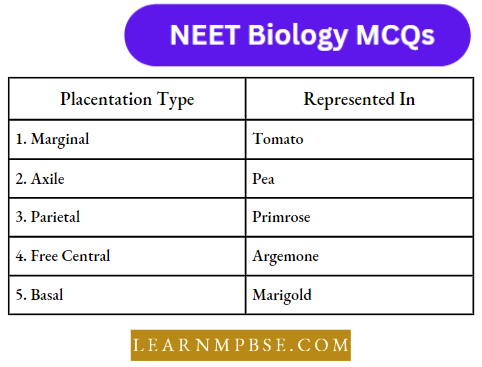
Answer: 5. Basal – marigold
Question 23. The seed coat is not thin, membranous in :
- Coconut
- Groundnut
- Gram
- Maize
Answer: 1. Coconut

